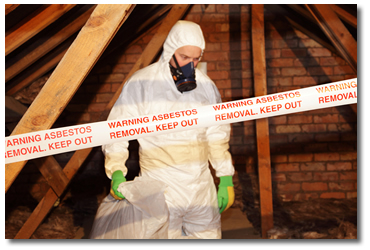Management of Asbestos Containing Materials on Demolition & Refurbishment Sites
 The Health & Safety Authority (the Authority) is specifically targeting this alert at all duty-holders involved in the management of demolition or refurbishment works including Clients, Project Supervisors for the Design Process (PSDP), Project Supervisors for the Construction Stage (PSCS), Designers (including architects, engineers etc.) and contractors to ensure Asbestos-Containing Materials (ACMs) are correctly identified before such works take place and are dealt with accordingly.
The Health & Safety Authority (the Authority) is specifically targeting this alert at all duty-holders involved in the management of demolition or refurbishment works including Clients, Project Supervisors for the Design Process (PSDP), Project Supervisors for the Construction Stage (PSCS), Designers (including architects, engineers etc.) and contractors to ensure Asbestos-Containing Materials (ACMs) are correctly identified before such works take place and are dealt with accordingly.
The Authority has recently engaged with a number of sites where evidence of poor practice or lack of understanding of ACM risk management required formal enforcement action to be taken. This included the issuing of Prohibition Notices that result in the cessation of work and effective site closure. Subject to the subsequent carrying out, by a competent person, of the required Refurbishment and Demolition Asbestos Survey (RDAS), some sites have incurred substantial clean-up costs and significant project delays.
Needless to say, of greatest concern is the serious exposure risk to which employees or others may have been subjected and its potential for the development of asbestos related diseases in years to come such as lung cancer and mesothelioma. All such incidents are investigated and may result in the prosecution of relevant parties including the Client, Designers, the PSDP, the PSCS and Contractors depending on the dutyholder failures and circumstances involved.
In particular the relevant duty holders must ensure:
- An RDAS is carried out by a competent person well in advance of commencement of site works to comply with the 2006/2010 Safety, Health and Welfare at Work Asbestos Regulations and the Safety Health and Welfare at Work (Construction) Regulations 2013 (the Construction Regulations). This facilitates effective planning of any necessary ‘pre-works’ ACM removals.
- An RDAS is relevant to all pre-2000 commercial, agricultural and domestic refurbishment and demolition sites.
- If a construction project presents a risk of disturbance of ACM, a PSDP and PSCS must be appointed in writing. Asbestos is a ‘Particular Risk’ as set out in Schedule 1 of the Construction Regulations.
- The Preliminary Safety and Health Plan drawn up by the PSDP must address all particular risks including asbestos. This should include the results/findings of any asbestos survey (RDAS).
- Where the site works are planned so as to avoid disturbance of any ACMs that are to remain in situ, the location of those ACMs must be communicated by the PSCS via the Safety and Health Plan to all contractors on site. This is to ensure that inadvertent disturbance of ACMs during the works is avoided
Leaving ACMs in situ for the duration of a refurbishment contract must be subject to a thorough risk assessment by a competent person.
- ACMs must be removed prior to demolition or to any refurbishment works which may cause disturbance. Removal must be carried out by competent trained contractors using appropriate safe working practices.
- All high risk ACMs e.g. laggings, insulating board etc. must be removed by specialist asbestos contractors under strictly controlled conditions and notified to the Authority 14 days in advance of asbestos removal commencing. A four-stage clearance process, including air monitoring, to assess the fitness for reoccupation (or, as appropriate, demolition) must be carried out by an independent, competent, asbestos analyst. A ‘certificate of reoccupation’ or ‘clearance certificate’ is issued by the analyst.
- Lower risk ACMs can be removed by a competent contractor with appropriate training, risk assessments and detailed method statements. Verification of complete removal, in the form of a certificate or written statement must be drawn up by the competent person who has carried out the necessary post-works checks, visual or otherwise.
- All asbestos waste must be disposed of in accordance with relevant waste legislation
- All relevant asbestos documents (asbestos surveys, clearance certification, waste certification etc.) must be filed in the Safety File for post-works handover to client.
The requirements stated above apply equally to all sectors including commercial, agricultural and domestic sites.
Additional Information
Asbestos, a category 1 carcinogen, is a well-known construction and demolition hazard in pre-2000 buildings. The Authority has produced comprehensive guidance on ACM management. This guidance clearly explains the approach to be taken and describes the level of competence required for the various tasks and roles involved.

